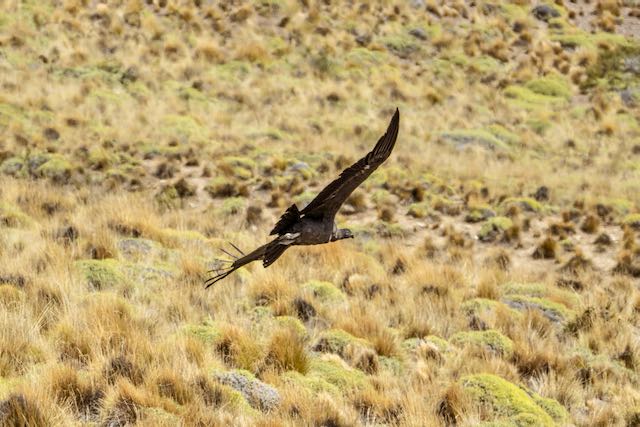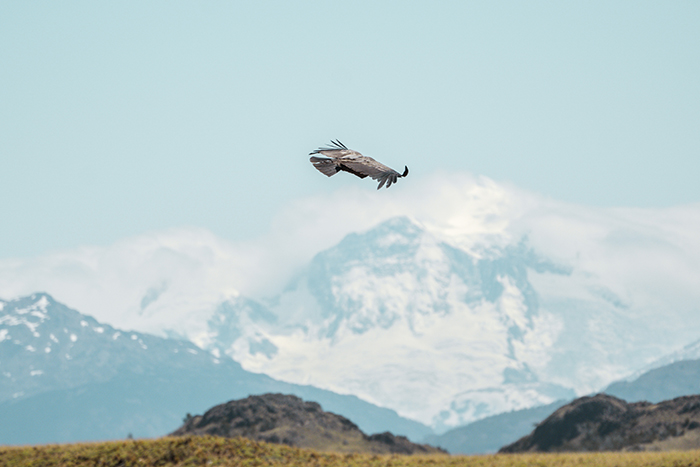Freed Andean Condors to Provide a Window into Wild Behavior in the Face of Habitat Pressures
Four Andean condors (Vultur gryphus) released in Patagonia National Park will reinforce the Patagonian population of the largest raptor in the world. This latest rewilding effort is a public and private collaboration between the Manku Project, Cortés Solari Philanthropy, Rewilding Chile, Centro de Rehabilitación de Aves Rapaces (CRAR), the Chilean Agricultural Service (SAG), ParqueMet Zoo, and Chile’s National Forest Corporation (CONAF).
Patagonia is home to 70% of the Andean condors in Chile, a country where they are increasingly under threat from ingesting carrion contaminated with poison used to control predators of domestic livestock. The species faces a steep decline in central Chile, an area densely populated by humans. A symbol of Andean culture for millennia, the Andean condor has a 10-foot wingspan, and lives in large groups. Individuals can live for up to 70 years.
This release is part of a unique collaboration between multiple institutions taking part in a multi-year management and recovery process. Of wild origin, two-year-old “Bagual” and three-year-old “Chicoco,” were rescued and subsequently rehabilitated at CRAR, while “Cuyén” and “Eclipse” were born in captivity at the same facility.
Restoring scavengers to their natural habitats is crucial to repairing ecosystems damaged by humans. In Chile, the country’s primary condor populations in the Central region and Patagonia are actively monitored. “Knowing their biology and the different situations faced by these two groups is fundamental to face the challenges of their conservation,” says Eduardo Pavez, director of the Manku Project.
For the director of wildlife at Rewilding Chile, Cristián Saucedo, “Releasing in the extreme south, where they still have abundant food sources, is very favorable for the condors. It also allows us, through satellite tracking, to study their behavior in one of the most pristine areas of the planet.”
The released condors carry satellite and radio transmitters to track their movements, integration with wild groups, and detect threats that may require intervention. The data will eventually allow researchers to identify flight paths, feeding sectors and breeding grounds key to the long-term survival of the species.
Prior to their release, the condors underwent a two-month acclimatization process in Patagonia National Park under the supervision of Rewilding Chile, the offspring of Tompkins Conservation, the organization whose land donation led to the creation of Patagonia National Park in 2018.
The Long Road to Release
A condor named Chicoco by the park gateway communities Chile Chico and Cochrane, a three-year-old male, was found in the area of Cajón del Maipo, outside Santiago, with severe bait poisoning. Bagual is a two-year-old male that had fallen from a nest as a chick in Villa O’Higgins, Aysén Region. The other two, Cuyén and Eclipse, a female and male, were born at the CRAR breeding center from wild parents that cannot be released.
After medical evaluations carried out by the Metropolitan Zoo, the condors were transferred some 2,000 kilometers from Santiago to Coyhaique via a commercial. They were then transferred to Patagonia National Park, via an 8-hour overland journey. In Patagonia National Park, they underwent acclimatization in an outdoor enclosure for two months, a fundamental process for the condors to socialize and adapt to the harsher climate and wild food sources.
According to Eduardo Pavez, director of the Manku Project and expert in the management of the species at AvesChile’s Center for the Rehabilitation of Birds of Prey (CRAR), “They continue to develop flock bonds, and have interactions with wild condors. All food and water is provided at night so that they have no human contact. And after two months, they are released and another very important stage begins, which is the monitoring of these condors based on the signals we receive from their radio and satellite transmitters.”
“The fact that Patagonia National Park lies in the flight path of different groups of Andean condors will be of enormous help for the newly-released condors to effectively integrate,” explained Cristián Saucedo, Director of the Wildlife Program at Rewilding Chile, a legacy organization of Tompkins Conservation.
A driving force to curb the worldwide climate emergency and the biodiversity crisis, Tompkins Conservation protects, rewilds, and defends land and marine ecosystems in the Southern Cone through collaborating to create national parks and rewilding key species. Working with public and private partners, the organization has helped to create 13 national parks, protecting 14.5 million acres. The goal is to restore a healthy planet with big, wild, and connected landscapes where animals and plants can thrive. This also means helping to build robust communities that benefit from a healthy natural world.
Kristine McDivitt Tompkins and Douglas Tompkins (1943-2015) founded Tompkins Conservation after leading iconic American clothing brands—Kristine as longtime CEO of Patagonia Inc, and Doug as co-founder of The North Face and Esprit. Changing course in the early 1990s to focus on conservation, they became two of the most successful conservation philanthropists in history. After Doug lost his life in a tragic kayaking accident in 2015, Kristine has continued to build on their foundation. She is now the president of Tompkins Conservation and a UN Environment Patron of Protected Areas.
A 501(c)(3) public charity, Tompkins Conservation carries out conservation projects through the nonprofit network of Rewilding Chile and Rewilding Argentina.




